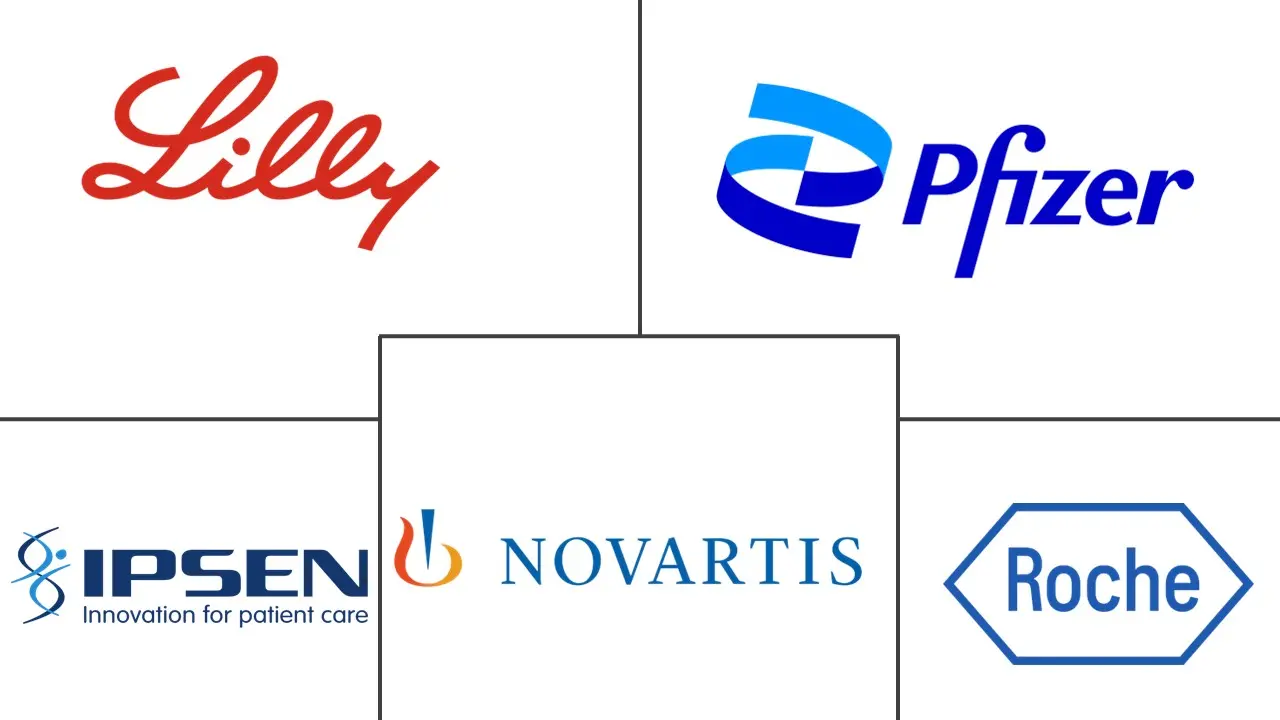Neuroendocrine Tumor Treatment Market Size and Share
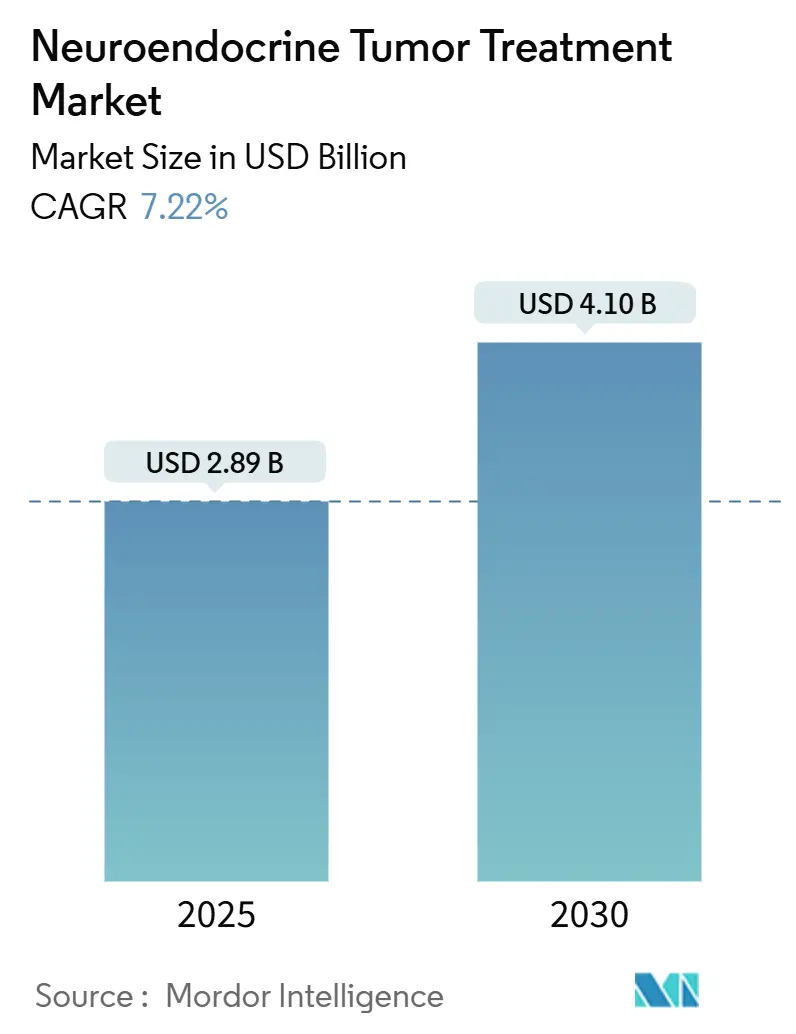
Neuroendocrine Tumor Treatment Market Analysis by Mordor Intelligence
The neuroendocrine tumor treatment market is valued at USD 2.89 billion in 2025 and is forecast to reach USD 4.10 billion by 2030, expanding at a 7.22% CAGR. Rapid capacity additions for medical isotopes, especially Lutetium-177, remove past supply bottlenecks and let hospitals adopt peptide receptor radionuclide therapy (PRRT) as a first-line option. Forthcoming PRRT guidelines, orphan-drug incentives and positive NETTER-2 data continue to widen clinical acceptance. Investors are backing vertically integrated radiopharmaceutical platforms, while liquid biopsy technologies such as NETest sharpen diagnosis and help match patients to targeted agents. Health systems also gain confidence from large deals—ITM’s NOVA plant and Curium’s Netherlands site—showing that the isotope supply chain can now scale.
Key Report Takeaways
- By treatment modality, somatostatin analogs led with 44.23% of neuroendocrine tumor treatment market share in 2024, while PRRT is projected to advance at a 10.32% CAGR to 2030.
- By indication, gastrointestinal tumors accounted for 37.65% of the neuroendocrine tumor treatment market in 2024; pancreatic NETs are set to expand at an 11.83% CAGR through 2030.
- By end user, hospitals held 60.46% of the neuroendocrine tumor treatment market size in 2024, whereas ambulatory surgery centers will post the fastest 9.82% CAGR to 2030.
- By region, North America commanded 39.87% share of the neuroendocrine tumor treatment market size in 2024, while APAC shows the strongest 10.06% CAGR to 2030.
Global Neuroendocrine Tumor Treatment Market Trends and Insights
Drivers Impact Analysis
| Driver | (~) % Impact on CAGR Forecast | Geographic Relevance | Impact Timeline |
|---|---|---|---|
| Rising prevalence of NETs | +1.2% | North America & Europe | Medium term (2-4 years) |
| Advances in imaging & diagnostics | +0.8% | Europe and North America | Short term (≤ 2 years) |
| Expansion of approved targeted & PRRT drugs | +1.5% | Early adoption in Europe | Medium term (2-4 years) |
| Orphan-drug incentives & favorable payment | +0.9% | North America & EU, moving to APAC | Long term (≥ 4 years) |
| Adoption of multi-analyte liquid biopsy | +0.6% | Europe and North America | Short term (≤ 2 years) |
| Inclusion of NETs in precision-oncology R&D | +0.7% | Developed markets | Long term (≥ 4 years) |
| Source: Mordor Intelligence | |||
Rising prevalence of NETs
Steadily improving imaging and population aging lift incidence, with Dutch registries counting nearly 1,000 new diagnoses in 2024. Health systems answer by launching specialist NET centers and funding isotope capacity. Clinical teams now detect earlier-stage disease, which broadens the candidate pool for PRRT and targeted agents. Industry surveys estimate 350,000 gastro-enteropancreatic NET patients across the EU and US who need long-term care. Multidisciplinary clinics thus adopt standardized pathways to manage rising caseloads efficiently.
Advances in imaging & diagnostics
NETest liquid biopsy tracks microscopic residual disease more accurately than legacy chromogranin A assays and is being validated across ENETS Centers of Excellence.[1]Sarah Hofland, “The NETest Liquid Biopsy Is Diagnostic for Gastric Neuroendocrine Tumors,” BMC Gastroenterology, bmcgastroenterol.biomedcentral.com When paired with high-resolution PET/CT, clinicians gain a near-real-time view of tumor biology and treatment response. This integration supports earlier therapy switches and underpins precision oncology programs now spreading from Europe to the United States. The upgrade shortens diagnostic delays, a long-standing barrier in NET care.
Expansion of approved targeted & PRRT drugs
EMA approval of Lutathera and positive NETTER-2 readouts shifted PRRT from salvage to frontline use, showing a 72% risk reduction in disease progression when combined with somatostatin analogs. Everolimus remains a backbone targeted option, while cabozantinib secured a positive CHMP opinion in June 2025, expanding choices for advanced disease. Trials now explore PARP-PRRT combos, signalling continued modality convergence.
Orphan-drug incentives & favorable reimbursement
Ten-year EU market exclusivity and US payment add-ons for diagnostic radiopharmaceuticals lower development risk for rare NET agents. CMS introduced separate payment when practical doses exceed the packaged threshold, smoothing hospital economics for new tracers. EMA’s simplified orphan pathway accelerates approvals for follow-on indications, encouraging sponsors to broaden label coverage.
Restraints Impact Analysis
| Restraint | (~) % Impact on CAGR Forecast | Geographic Relevance | Impact Timeline |
|---|---|---|---|
| High cost of novel therapeutics | −1.1% | Most pronounced in emerging markets | Medium term (2-4 years) |
| Limited physician awareness & diagnostic lag | −0.8% | Developing regions | Short term (≤ 2 years) |
| Safety concerns with PRRT/chemo regimens | −0.5% | Regulatory focus in developed markets | Long term (≥ 4 years) |
| Isotope (Lu-177/Ga-68) supply bottlenecks | −0.9% | Acute in high-demand regions | Short term (≤ 2 years) |
| Source: Mordor Intelligence | |||
High cost of novel therapeutics
Lutathera infusions require shielded suites, radiation monitoring and specialist staff, pushing total treatment costs well above the drug price. Health technology assessment bodies in Europe now scrutinize cost-per-QALY results before adding agents to formularies. Multidisciplinary hubs are emerging to pool patient volumes, cut duplication and improve cost-effectiveness.
Isotope (Lu-177/Ga-68) supply bottlenecks
Although ITM’s NOVA plant is the largest producer worldwide, global demand still outpaces supply during maintenance outages. Projects like IHI-ILLUMINATE aim to recycle ytterbium feedstock and reduce upstream choke points. Meanwhile, ASP Isotopes is building an enrichment line for Yb-176 in South Africa, a move designed to diversify regional production aspisotopes.com.
Segment Analysis
By Treatment Modality: PRRT emerges as growth engine
Somatostatin analogs retained 44.23% share in the neuroendocrine tumor treatment market during 2024, reflecting long-standing use for symptom control and tumor stabilization. PRRT, buoyed by community uptake of [¹⁷⁷Lu]Lu-Oxodotreotide, is projected to log a 10.32% CAGR and stands out as the primary growth engine. PRRT protocols gained uniformity through the Italian Association of Nuclear Medicine’s new guidelines, encouraging broader European uptake. Parallel advances in manufacturing assure a reliable isotope stream, further sustaining momentum.
Clinical preference now shifts toward combination regimens—PRRT plus somatostatin analogs, or PRRT alongside DNA-repair inhibitors under investigation—thereby widening the addressable population. Chemotherapy preserves its role for poorly differentiated carcinomas, while emerging immunotherapy–chemotherapy trials explore synergy in high-grade disease.[2]Javier Lamarca, “Nivolumab Plus Platinum-Chemotherapy in Advanced Grade 3 NEC: NICE-NEC Trial,” Nature Communications, nature.com Targeted therapy, led by everolimus and cabozantinib, offers individualized options for patients unsuitable for radionuclide therapy, underscoring how the neuroendocrine tumor treatment market keeps diversifying.
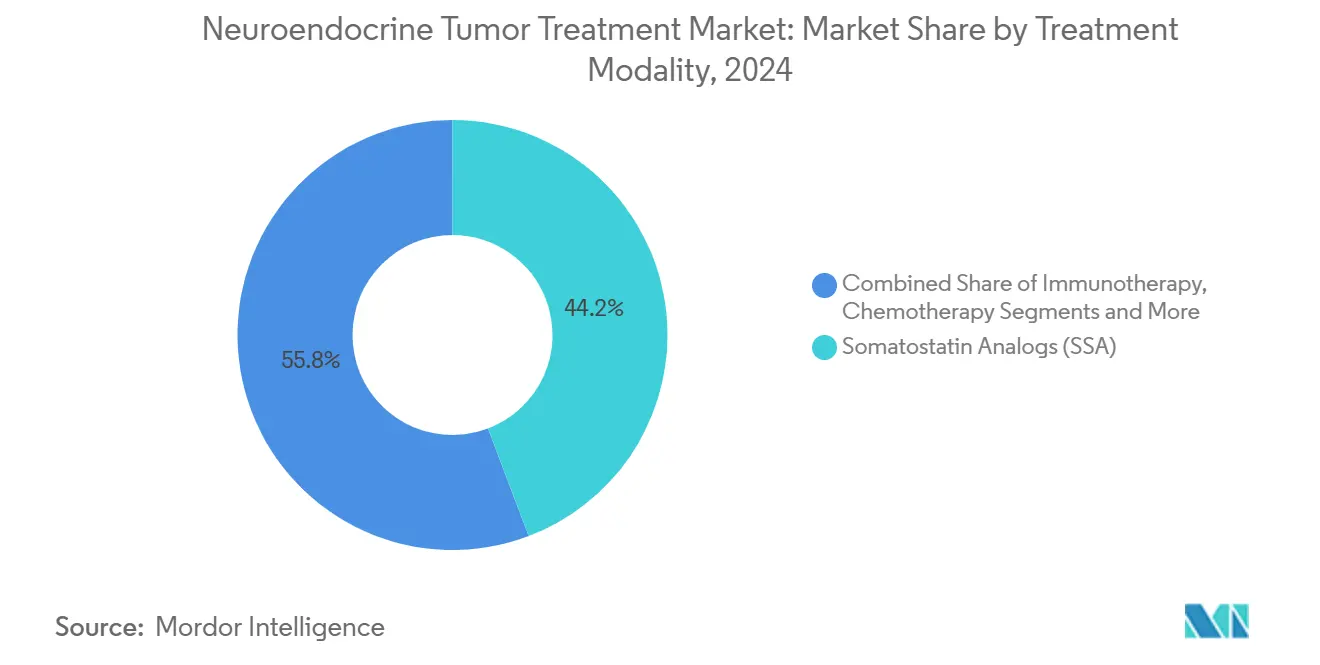
Note: Segment shares of all individual segments available upon report purchase
By Indication: Pancreatic NETs drive innovation
Gastrointestinal tumors represented 37.65% of the neuroendocrine tumor treatment market in 2024, anchored by mature clinical pathways and routine use of somatostatin analogs. Pancreatic NETs are the growth frontier, exhibiting an 11.83% CAGR to 2030, supported by everolimus, cabozantinib and prospective PRRT studies targeting this subgroup.[3]Ana E. Rodríguez-López, “A Randomized Clinical Trial Evaluating 177Lu-Edotreotide Versus Everolimus in Lung and Thymus NETs: The LEVEL Study,” BMC Cancer, bmccancer.biomedcentral.com Lung and thymus NETs also see heightened research interest, with the LEVEL trial highlighting potential survival gains from ¹⁷⁷Lu-edotreotide.
Tumor biology varies widely across sites, prompting investigators to stratify trials by primary location. Midgut lesions often respond best to PRRT, while pancreatic primaries benefit from sequential targeted and surgical approaches. This heterogeneity drives continuous protocol refinement and fuels product development across the neuroendocrine tumor treatment industry.
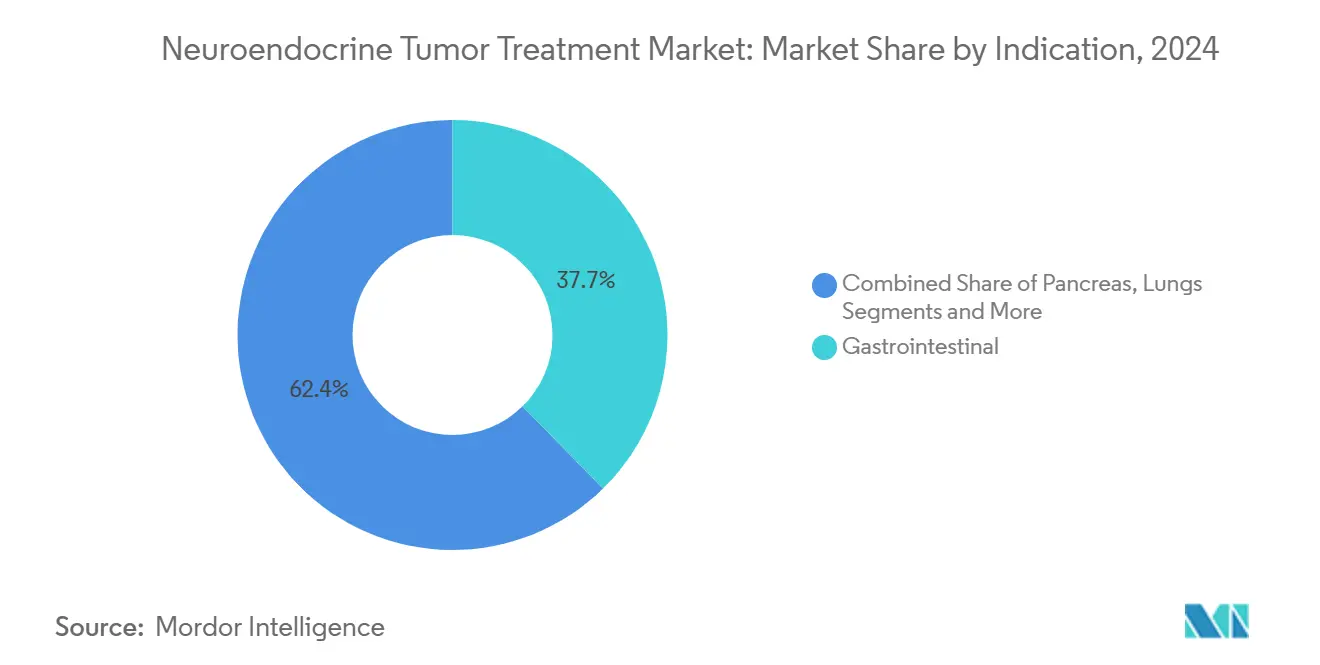
Note: Segment shares of all individual segments available upon report purchase
By End User: Ambulatory centers gain momentum
Hospitals controlled 60.46% of the neuroendocrine tumor treatment market share in 2024 thanks to in-house nuclear medicine suites and multidisciplinary teams. Outpatient PRRT protocols, however, are shifting administration toward ambulatory surgery centers, which are forecast to grow at 9.82% CAGR. These centers leverage streamlined pathways that shorten patient stay and lower overhead. Specialty oncology clinics partner with isotope suppliers to embed theranostic services, further fragmenting the delivery landscape.
Academic hospitals remain innovation hubs, conducting pivotal trials that shape future standards. Their collaborations with commercial isotope producers ensure early access to next-generation compounds, allowing faster bench-to-bedside translation. This interplay sustains the neuroendocrine tumor treatment market’s technology pipeline while broadening community reach.
Geography Analysis
North America led with 39.87% share of the neuroendocrine tumor treatment market size in 2024. Medicare’s separate payment for high-cost tracers and the FDA’s track record of timely approvals underpin early adoption. Major US cancer centers already integrate PRRT with targeted and checkpoint inhibitors in trial settings, while Canada’s universal system reimburses core PRRT indications nationally.
Europe benefits from the EMA’s orphan-drug pathway and coordinated payer frameworks that streamline access to rare-disease therapies. Local isotope capacity, notably Curium’s Netherlands Lu-177 line, strengthens supply security. Germany, France and the United Kingdom host dense networks of ENETS-accredited centers, ensuring consistent quality across borders. Southern European nations expand capabilities through EU cohesion funds and shared training programs.
Asia-Pacific posts the highest 10.06% CAGR, powered by Japan’s swift regulatory clearance of diagnostic agents and China’s oncology infrastructure build-out. Australia subsidizes PRRT under the Pharmaceutical Benefits Scheme, while South Korea and India establish partnerships with European isotope firms. Regional manufacturers invest in domestic supply chains to avoid import delays, further accelerating neuroendocrine tumor treatment market penetration.
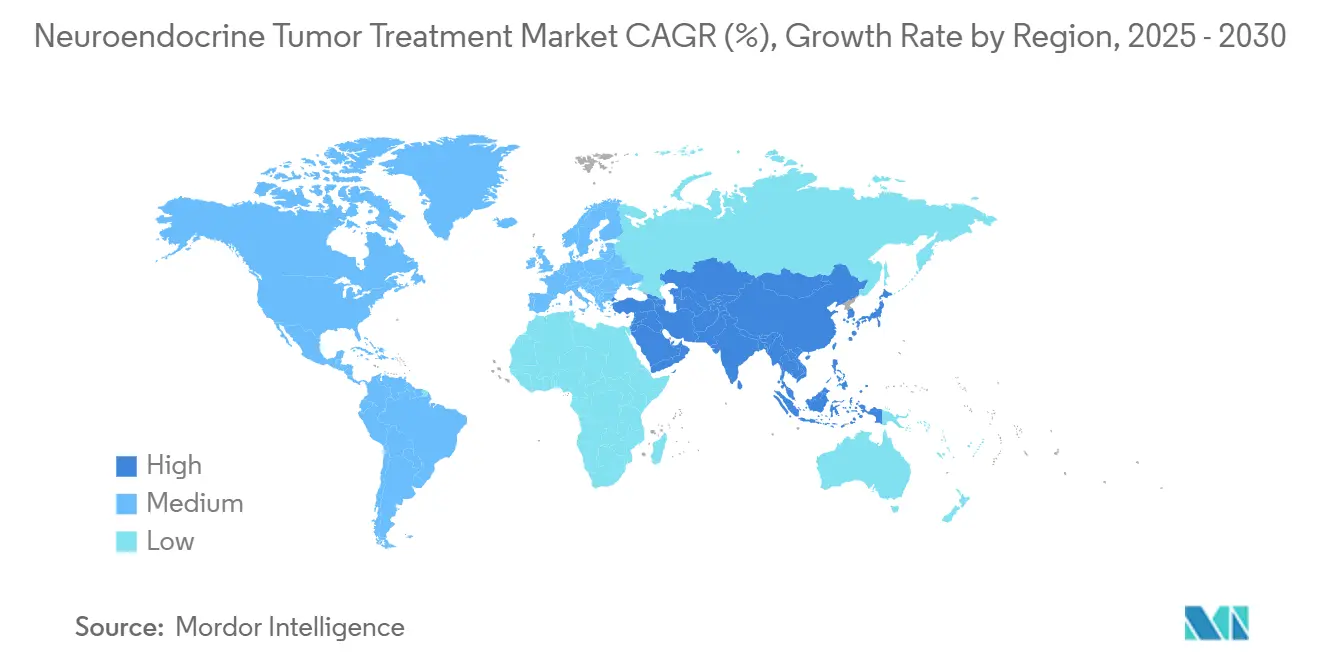
Competitive Landscape
The neuroendocrine tumor treatment market shows moderate concentration as established pharmaceuticals race emerging radiopharmaceutical specialists. Lantheus deployed more than USD 1 billion on Evergreen Theragnostics and Life Molecular Imaging to secure isotope production and novel tracers. Novartis remains a cornerstone player, sustaining Lutathera post-marketing studies and combining assets with somatostatin analogs. Ipsen expanded its cabozantinib license following strong Phase III data in advanced NETs.
Specialists such as ITM, Curium and Eckert & Ziegler vertically integrate isotope enrichment and drug manufacturing, protecting margins and supply reliability. Crinetics pursues oral paltusotine for carcinoid syndrome, adding a non-radiopharmaceutical differentiator. Academic–industry consortia accelerate alpha-particle research, hinting at next-wave competition. Together, these moves keep pricing pressure in check while broadening therapeutic choices for clinicians worldwide.
Neuroendocrine Tumor Treatment Industry Leaders
-
Pfizer Inc.
-
Novartis AG
-
Ipsen
-
Eli Lilly & Company
-
F. Hoffmann-La Roche Ltd.
- *Disclaimer: Major Players sorted in no particular order
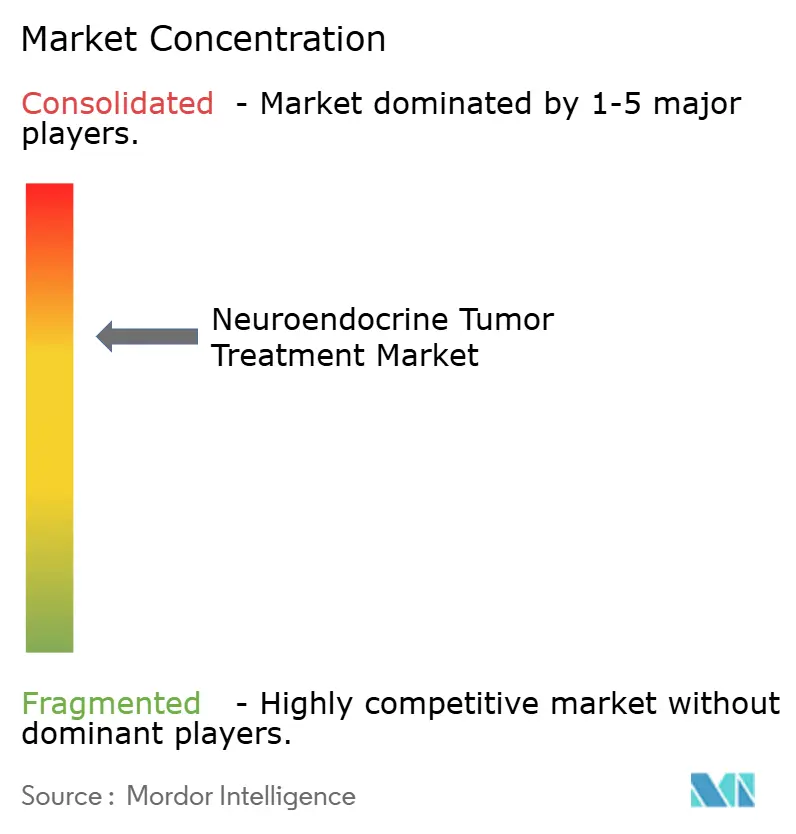


Recent Industry Developments
- June 2025: Ipsen received a positive CHMP opinion recommending Cabometyx for advanced pancreatic and extra-pancreatic NETs.
- March 2025: Exelixis gained FDA approval for CABOMETYX in adult and adolescent patients with previously treated well-differentiated pancreatic and extra-pancreatic NETs.
Research Methodology Framework and Report Scope
Market Definitions and Key Coverage
Our study defines the neuroendocrine tumor (NET) treatment market as all branded and generic prescription drugs and radiopharmaceuticals used to control or cure well- or poorly differentiated NETs arising in the gastrointestinal tract, pancreas, lung, and rarer extra-pulmonary sites. Revenues are captured at the manufacturer level in U.S. dollars for somatostatin analogs, peptide-receptor radionuclide therapy, targeted small-molecule inhibitors, and cytotoxic regimens.
Scope exclusion: Surgical procedures, diagnostic imaging equipment, pathology services, and non-oncology symptom aids are not valued.
Segmentation Overview
- By Treatment Modality
- Somatostatin Analogs (SSA)
- Peptide Receptor Radionuclide Therapy (PRRT)
- Targeted Therapy (TKI/mTOR)
- Immunotherapy (ICI)
- Chemotherapy
- Others (Interferons, Supportive)
- By Indication
- Gastrointestinal (Mid-gut)
- Pancreas
- Lung
- Other NET Sites
- By End User
- Hospitals
- Specialty/Oncology Clinics
- Ambulatory Surgery Centers
- Academic & Research Institutes
- By Geography
- North America
- United States
- Canada
- Mexico
- Europe
- Germany
- United Kingdom
- France
- Italy
- Spain
- Rest of Europe
- Asia-Pacific
- China
- Japan
- India
- Australia
- South Korea
- Rest of Asia-Pacific
- Middle East and Africa
- GCC
- South Africa
- Rest of Middle East and Africa
- South America
- Brazil
- Argentina
- Rest of South America
- North America
Detailed Research Methodology and Data Validation
Primary Research
Mordor analysts interviewed medical oncologists, nuclear medicine physicians, hospital pharmacists, and payor advisers across North America, Europe, and Asia-Pacific. Their experience with dosing schedules, line of therapy shifts, and net pricing corridors allowed us to refine desk assumptions and close remaining gaps.
Desk Research
We first mapped disease burden with open registries such as GLOBOCAN, SEER, and the International Agency for Research on Cancer. We then layered in therapy uptake insights from FDA and EMA approval dossiers, reimbursement catalogs, and peer-reviewed journals cited by the North American Neuroendocrine Tumor Society. Company financials from D&B Hoovers, news flows on Dow Jones Factiva, and Questel patent counts helped us trace brand revenue curves and pipeline pressure. These references illustrate, rather than exhaust, the wide set of sources our analysts mine and cross-check.
Market-Sizing & Forecasting
A top-down incidence to treated patient funnel converts country epidemiology into demand pools, which are multiplied by validated treatment share and average therapy cost. Bottom-up brand roll-ups serve as a sense check and are reconciled through one pass of top-down versus bottom-up triangulation. Key variables like diagnosed cases, functional versus non-functional split, generic SSA erosion, PRRT second-line uptake, and radioligand launch cadence feed a multivariate regression that builds the 2025-2030 outlook.
Data Validation & Update Cycle
Outputs run through variance dashboards, peer review, and senior sign-off. We refresh the model annually and reopen interviews when material events such as landmark approvals or pricing reforms occur, so clients receive the latest balanced view.
Why our Neuroendocrine Tumor Treatment Baseline is dependable
Published values often differ because each firm picks its own service scope, price basis, and refresh tempo. We begin with live cancer registry counts, apply net manufacturer pricing, and re-weight every geography each year, which curbs distortion and keeps Asia-Pacific growth visible. Others who blend diagnostic revenue or freeze epidemiology can drift away from reality.
Benchmark comparison
| Market Size | Anonymized source | Primary gap driver |
|---|---|---|
| US$ 2.89 Bn (2025) | Mordor Intelligence | - |
| US$ 2.66 Bn (2024) | Global Consultancy A | Uses list prices and omits PRRT revenue outside North America |
| US$ 2.71 Bn (2024) | Industry Publisher B | Applies blanket uplift to historic sales and keeps incidence static |
The comparison highlights that Mordor's disciplined scope choices, live variable tracking, and annual refresh deliver a transparent baseline that decision-makers can trace and replicate with confidence.


Key Questions Answered in the Report
1. What is the current size of the neuroendocrine tumor treatment market?
The market stands at USD 2.89 billion in 2025 and is expected to reach USD 4.10 billion by 2030 at a 7.22% CAGR.
2. Which therapy class leads revenue today?
Somatostatin analogs remain the largest class, holding 44.23% of 2024 revenue.
3. Why is peptide receptor radionuclide therapy (PRRT) growing so quickly?
Positive NETTER-2 outcomes and expanded isotope supply enable PRRT to register a 10.32% CAGR, making it the fastest-growing modality.
4. Which region is expanding fastest?
Asia-Pacific shows the highest 10.06% CAGR as diagnostic capacity and reimbursement improve.
Page last updated on:
